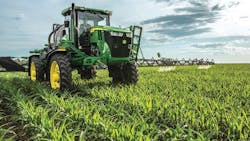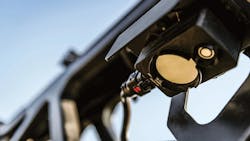John Deere Uses Machine Vision and Machine Learning to Automate Agriculture
John Deere continues to add machine vision technology to its agricultural equipment and products. The goal is to automate workloads, improving efficiency.
The most recent announcement from Deere & Company, which markets itself as John Deere, (Moline, IL, USA; www.deere.com) is an upgrade kit for self-propelled herbicide sprayers. Farmers use the sprayers, called See & Spray, to eliminate weeds both before planting crops and during the growing season.
This announcement follows the introduction last year of an autonomous tractor that includes a camera-based solution made up of six stereo cameras that provide 360° visibility around the tractor.
John Deere introduced the first See & Spray model incorporating machine vision technology in 2021. Called the See & Spray Select, the piece of equipment uses machine vision to spot green weeds against the background of brown soil and then activate nozzles to spray only the weeds. This approach to applying herbicides allows farmers to use less product because they are not spraying an entire field indiscriminately, saving money and lessening their negative impact on the environment.
John Deere estimates savings of up to two-thirds in the volume of herbicide solution farmers will use in their fields with the upgraded sprayers.
Applying Machine Vision Technology
In 2022, John Deere introduced a See & Spray model, the Ultimate, incorporating both machine vision and machine learning to pick out green weeds growing amid row crops and then activate sprayers to eliminate only the weeds. The equipment works with cotton, soybeans, and corn. Farmers also can use this model to spray herbicides before planting crops.
The company introduced the add-on kit, See & Spray Premium in March 2023. The kit allows farmers to upgrade existing sprayers (model year 2018 or newer) with machine vision and machine learning technology.
To capture images of a field, all three versions of See & Spray utilize 36 industrial cameras spaced 1 m apart and mounted on a 120-ft sprayer boom. Within milliseconds, a machine learning model uses multiple images captured by the cameras to differentiate the weeds from either row crops or fallow (pre-planting) ground. Once a weed is detected, the software sends a command to the appropriate nozzle, also mounted on the boom, to spray it.
The machine vision/machine learning technology was designed by Blue River Technology (Sunnyvale, CA, USA; https://bluerivertechnology.com/), a wholly owned subsidiary of Deere & Company focused on creating intelligent machinery.
Training Deep Learning Networks
“It is all based on deep learning and convolutional neural networks developed over the past seven years,” says Chris Padwick, Director of Computer Vision/ Machine Learning at Blue River.
The networks were trained with a database of “hundreds and hundreds of gigabytes” that contains millions of images, he explains. To continually improve the performance of the neural networks, the company updates the database regularly with new labelled images, Padwick adds.
The See & Spray models include a computer and monitor, and they do not need to communicate with software in the cloud while they are operating in the field. During operation, the software displays a map on the monitor, showing where the equipment has applied herbicide.
However, the data on herbicide use is also transmitted to John Deere’s cloud-based analytics software. By logging into their account, farmers can study the herbicide data and gain insights about the weeds growing in their fields.
Describing the proprietary cameras as “truly John Deere designed,” Padwick says the company engineered them to be capable of capturing images in high resolution while also being rugged enough to withstand the typical weather conditions in the field, which include rain and extreme heat or cold.
As a result, the process to test cameras involves such procedures as dunking them in water for one minute, he says.
When asked what is next on John Deere’s agenda, Padwick says the company is working on opportunities to apply machine vision and machine learning technology to equipment the company sells in other industries such as mining, construction, and forestry.
About the Author
Linda Wilson
Editor in Chief
Linda Wilson joined the team at Vision Systems Design in 2022. She has more than 25 years of experience in B2B publishing and has written for numerous publications, including Modern Healthcare, InformationWeek, Computerworld, Health Data Management, and many others. Before joining VSD, she was the senior editor at Medical Laboratory Observer, a sister publication to VSD.


